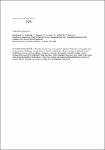Multilocus sequence typing of Scedosporium apiospermum and Pseudallescheria boydii isolates from cystic fibrosis patients
Bernhardt, Anne
Sedlacek, L.
Wagner, S.
Schwarz, C.
Würstl, B.
Tintelnot, Kathrin
Background: Scedosporium and Pseudallescheria species are the second most common lung-colonising fungi in cystic fibrosis (CF) patients. For epidemiological reasons it is important to trace sources of infection, routes of transmission and to determine whether these fungi are transient or permanent colonisers of the respiratory tract. Molecular typing methods like multilocus sequence typing (MLST) help provide this data. Methods: Clinical isolates of the P. boydii complex (including S. apiospermum and P. boydii) from CF patients in different regions of Germany were studied using MLST. Five gene loci, ACT, CAL, RPB2, BT2 and SOD2, were analysed. Results: The S. apiospermum isolates from 34 patients were assigned to 32 sequence types (STs), and the P. boydii isolates from 14 patients to 8 STs. The results revealed that patients can be colonised by individual strains for years. Conclusions: The MLST scheme developed for S. apiospermum and P. boydii is a highly effective tool for epidemiologic studies worldwide. The MLST data are accessible at http://mlst.mycologylab.org/.
Dateien zu dieser Publikation
Keine Lizenzangabe

